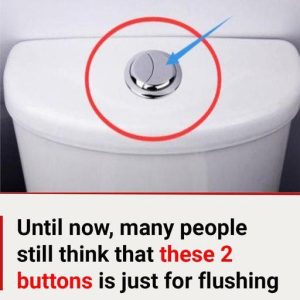Many modern toilets have dual flush buttons designed to save water. The larger button typically uses 6–9 liters of water to flush solid waste, while the smaller button consumes just 3–4.5 liters for liquid waste, helping conserve significant amounts of water.

What is a Dual Flush Toilet?: Dual flush toilets feature two buttons or levers of different sizes, each controlling a separate exit valve. The larger button handles bigger flushes, while the smaller one is meant for lighter flushes.
Why It Matters: By switching to a dual flush system, households can save up to 20,000 liters of water annually. Though slightly costlier than traditional toilets, dual flush systems are eco-friendly and efficient.
Origins and Usage: The concept was introduced by Victor Papanek in his 1976 book Design for the Real World and first implemented in Australia in 1980.
Smart Flushing Tips: Use the smaller button, marked by a symbol like a droplet or half-circle, for liquid waste and the larger button for solid waste. This simple habit makes a significant difference in water conservation!
How Dual Flush Toilets Work
Dual flush toilets operate by providing two flushing options to cater to different types of waste. Inside the tank, a specially designed mechanism controls the water release. The smaller button triggers a partial flush using less water, while the larger button activates a full flush for solid waste. This smart engineering helps maintain hygiene while significantly reducing water usage.
Environmental Benefits of Dual Flush Toilets
The environmental impact of dual flush toilets is remarkable. By reducing unnecessary water consumption, they lower the strain on local water supplies and sewage systems. In drought-prone regions, this technology plays a crucial role in conserving valuable resources. Widespread adoption of dual flush systems could contribute to global water conservation efforts and help mitigate water scarcity.
Economic Advantages for Households
While dual flush toilets may have a higher upfront cost, they provide long-term savings. Reduced water consumption translates to lower water bills over time. For households looking to balance eco-conscious living with cost efficiency, these systems are an excellent investment. Many governments also offer rebates or incentives for installing water-efficient appliances, further reducing the initial expense.
Global Adoption and Trends
Since their inception in Australia, dual flush toilets have gained popularity worldwide. Countries with strict water conservation policies, such as Germany, Japan, and the United States, encourage the use of these systems in homes and commercial spaces. The integration of dual flush mechanisms into modern smart toilets has further enhanced their functionality, making them even more user-friendly and appealing.
Promoting Awareness and Proper Usage
Public awareness campaigns can encourage more people to install dual flush toilets. Educating users about the importance of proper button usage—smaller flushes for liquid waste and larger for solids—can maximize their effectiveness. Schools, workplaces, and community centers can lead by example by upgrading to dual flush systems and teaching users about their benefits.
By embracing dual flush toilets and promoting their use, we can collectively make a significant contribution to water conservation, environmental protection, and sustainable living. Let's flush smarter for a better future!